Principles of Business Report: Apple Corporation Market Analysis in UK
VerifiedAdded on 2020/06/05
|10
|3315
|49
Report
AI Summary
This report provides an in-depth analysis of business principles, using Apple Corporation in the UK as a case study. It examines various aspects, including characteristics of different business markets, the nature of interactions between businesses, and how organizational goals are shaped by market dynamics. The report delves into business innovation, exploring its definition, models, sources of support, the product/service development process, and associated benefits, risks, and implications. Financial viability, its importance, and the consequences of poor financial management are also discussed, alongside an overview of financial terminology. Furthermore, the report covers budgeting, marketing principles, the sales process, market research, brand value, and the relationship between sales and marketing. The assignment highlights the importance of legal obligations for businesses and concludes with a comprehensive overview of the key principles discussed. This report is designed to provide a thorough understanding of business operations and strategy.
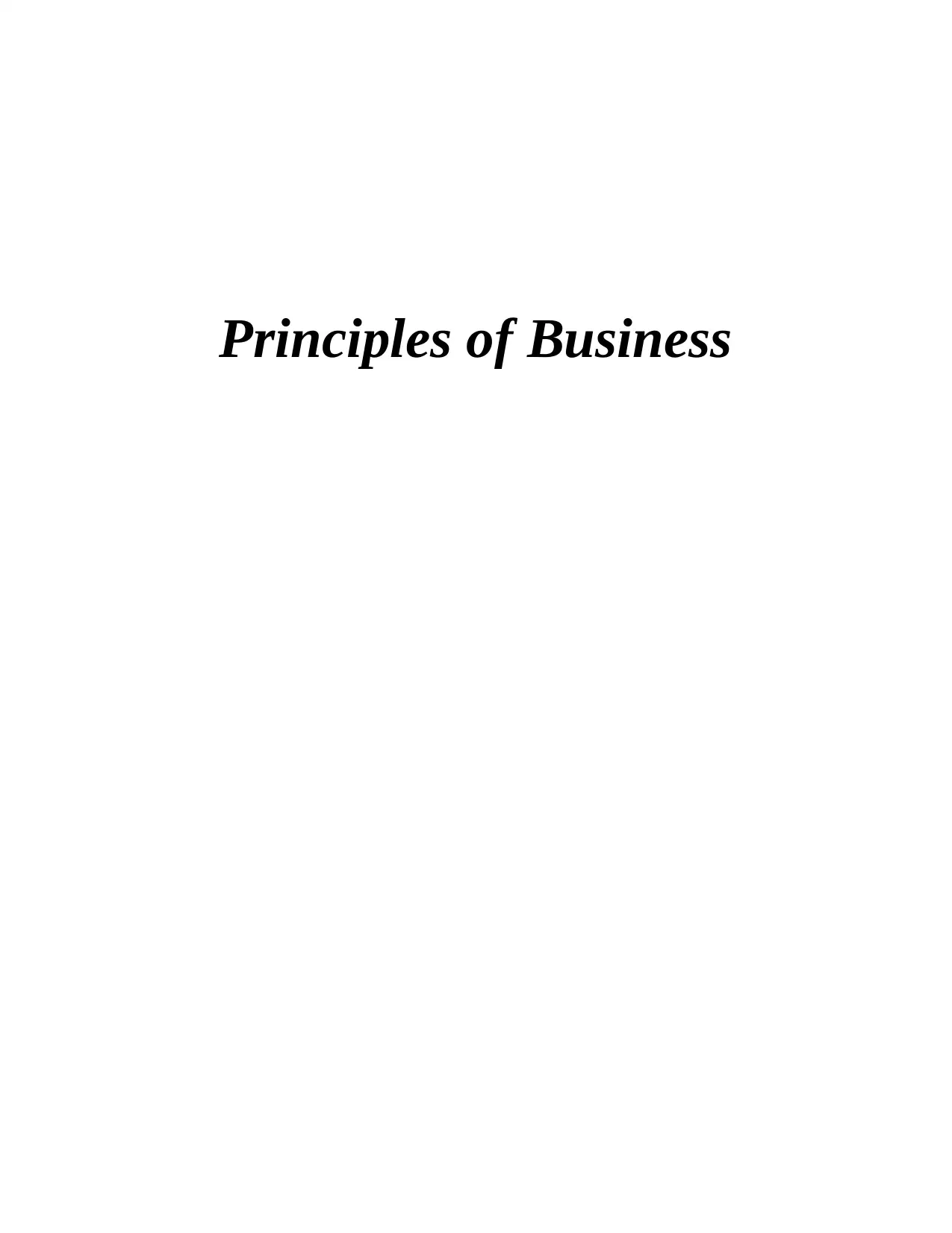
Principles of Business
Paraphrase This Document
Need a fresh take? Get an instant paraphrase of this document with our AI Paraphraser
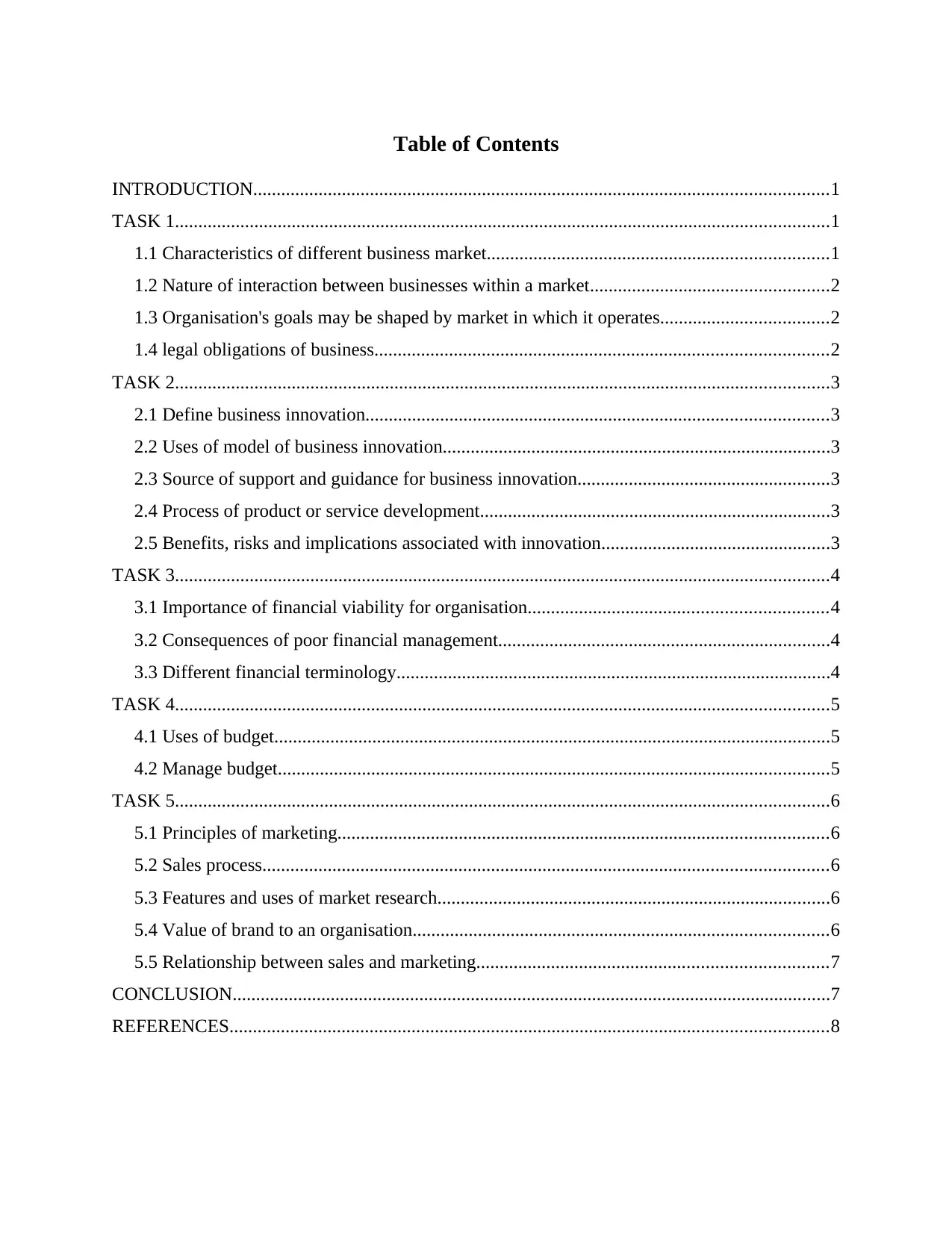
Table of Contents
INTRODUCTION...........................................................................................................................1
TASK 1............................................................................................................................................1
1.1 Characteristics of different business market.........................................................................1
1.2 Nature of interaction between businesses within a market...................................................2
1.3 Organisation's goals may be shaped by market in which it operates....................................2
1.4 legal obligations of business.................................................................................................2
TASK 2............................................................................................................................................3
2.1 Define business innovation...................................................................................................3
2.2 Uses of model of business innovation...................................................................................3
2.3 Source of support and guidance for business innovation......................................................3
2.4 Process of product or service development...........................................................................3
2.5 Benefits, risks and implications associated with innovation.................................................3
TASK 3............................................................................................................................................4
3.1 Importance of financial viability for organisation................................................................4
3.2 Consequences of poor financial management.......................................................................4
3.3 Different financial terminology.............................................................................................4
TASK 4............................................................................................................................................5
4.1 Uses of budget.......................................................................................................................5
4.2 Manage budget......................................................................................................................5
TASK 5............................................................................................................................................6
5.1 Principles of marketing.........................................................................................................6
5.2 Sales process.........................................................................................................................6
5.3 Features and uses of market research....................................................................................6
5.4 Value of brand to an organisation.........................................................................................6
5.5 Relationship between sales and marketing...........................................................................7
CONCLUSION................................................................................................................................7
REFERENCES................................................................................................................................8
INTRODUCTION...........................................................................................................................1
TASK 1............................................................................................................................................1
1.1 Characteristics of different business market.........................................................................1
1.2 Nature of interaction between businesses within a market...................................................2
1.3 Organisation's goals may be shaped by market in which it operates....................................2
1.4 legal obligations of business.................................................................................................2
TASK 2............................................................................................................................................3
2.1 Define business innovation...................................................................................................3
2.2 Uses of model of business innovation...................................................................................3
2.3 Source of support and guidance for business innovation......................................................3
2.4 Process of product or service development...........................................................................3
2.5 Benefits, risks and implications associated with innovation.................................................3
TASK 3............................................................................................................................................4
3.1 Importance of financial viability for organisation................................................................4
3.2 Consequences of poor financial management.......................................................................4
3.3 Different financial terminology.............................................................................................4
TASK 4............................................................................................................................................5
4.1 Uses of budget.......................................................................................................................5
4.2 Manage budget......................................................................................................................5
TASK 5............................................................................................................................................6
5.1 Principles of marketing.........................................................................................................6
5.2 Sales process.........................................................................................................................6
5.3 Features and uses of market research....................................................................................6
5.4 Value of brand to an organisation.........................................................................................6
5.5 Relationship between sales and marketing...........................................................................7
CONCLUSION................................................................................................................................7
REFERENCES................................................................................................................................8
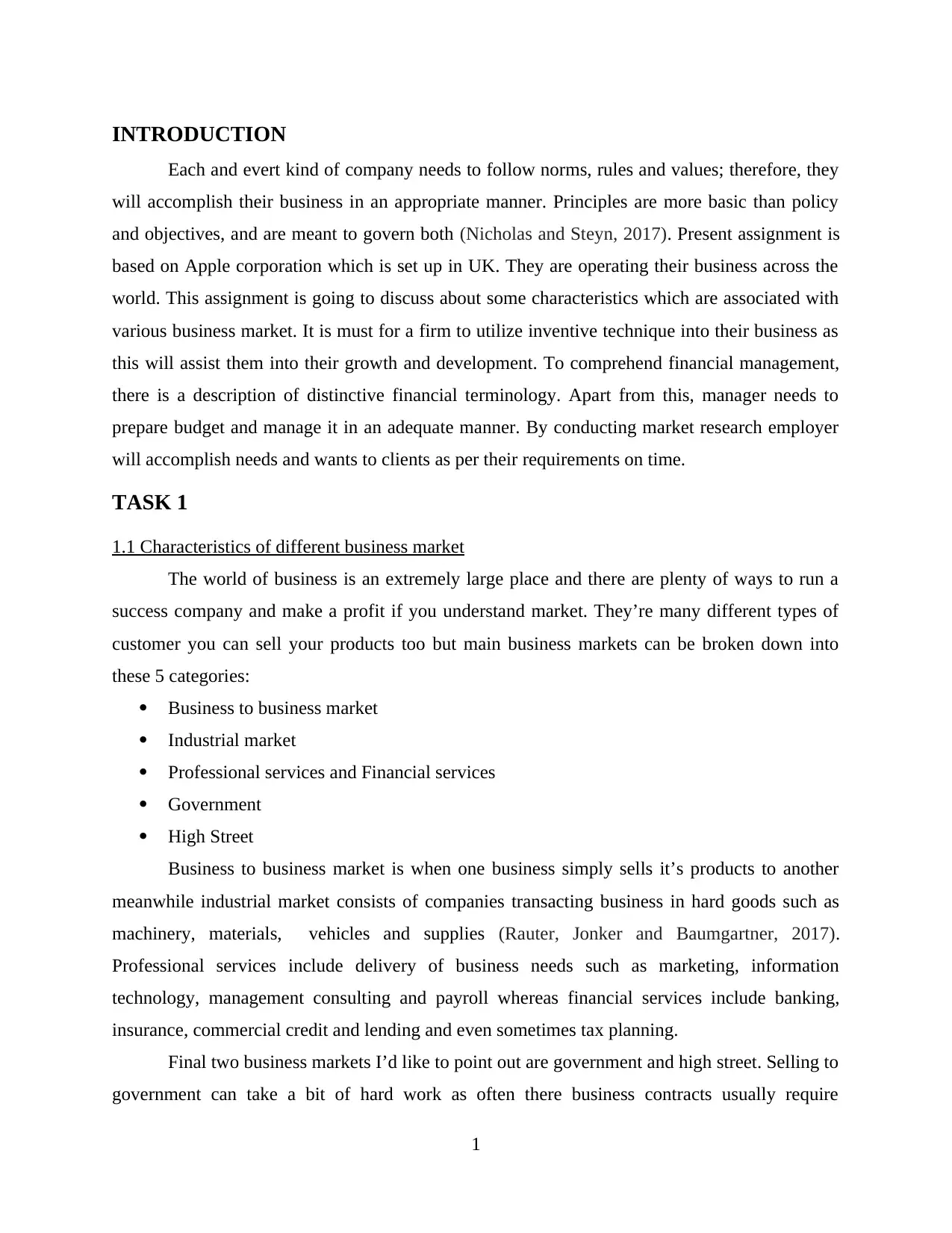
INTRODUCTION
Each and evert kind of company needs to follow norms, rules and values; therefore, they
will accomplish their business in an appropriate manner. Principles are more basic than policy
and objectives, and are meant to govern both (Nicholas and Steyn, 2017). Present assignment is
based on Apple corporation which is set up in UK. They are operating their business across the
world. This assignment is going to discuss about some characteristics which are associated with
various business market. It is must for a firm to utilize inventive technique into their business as
this will assist them into their growth and development. To comprehend financial management,
there is a description of distinctive financial terminology. Apart from this, manager needs to
prepare budget and manage it in an adequate manner. By conducting market research employer
will accomplish needs and wants to clients as per their requirements on time.
TASK 1
1.1 Characteristics of different business market
The world of business is an extremely large place and there are plenty of ways to run a
success company and make a profit if you understand market. They’re many different types of
customer you can sell your products too but main business markets can be broken down into
these 5 categories:
Business to business market
Industrial market
Professional services and Financial services
Government
High Street
Business to business market is when one business simply sells it’s products to another
meanwhile industrial market consists of companies transacting business in hard goods such as
machinery, materials, vehicles and supplies (Rauter, Jonker and Baumgartner, 2017).
Professional services include delivery of business needs such as marketing, information
technology, management consulting and payroll whereas financial services include banking,
insurance, commercial credit and lending and even sometimes tax planning.
Final two business markets I’d like to point out are government and high street. Selling to
government can take a bit of hard work as often there business contracts usually require
1
Each and evert kind of company needs to follow norms, rules and values; therefore, they
will accomplish their business in an appropriate manner. Principles are more basic than policy
and objectives, and are meant to govern both (Nicholas and Steyn, 2017). Present assignment is
based on Apple corporation which is set up in UK. They are operating their business across the
world. This assignment is going to discuss about some characteristics which are associated with
various business market. It is must for a firm to utilize inventive technique into their business as
this will assist them into their growth and development. To comprehend financial management,
there is a description of distinctive financial terminology. Apart from this, manager needs to
prepare budget and manage it in an adequate manner. By conducting market research employer
will accomplish needs and wants to clients as per their requirements on time.
TASK 1
1.1 Characteristics of different business market
The world of business is an extremely large place and there are plenty of ways to run a
success company and make a profit if you understand market. They’re many different types of
customer you can sell your products too but main business markets can be broken down into
these 5 categories:
Business to business market
Industrial market
Professional services and Financial services
Government
High Street
Business to business market is when one business simply sells it’s products to another
meanwhile industrial market consists of companies transacting business in hard goods such as
machinery, materials, vehicles and supplies (Rauter, Jonker and Baumgartner, 2017).
Professional services include delivery of business needs such as marketing, information
technology, management consulting and payroll whereas financial services include banking,
insurance, commercial credit and lending and even sometimes tax planning.
Final two business markets I’d like to point out are government and high street. Selling to
government can take a bit of hard work as often there business contracts usually require
1
⊘ This is a preview!⊘
Do you want full access?
Subscribe today to unlock all pages.

Trusted by 1+ million students worldwide
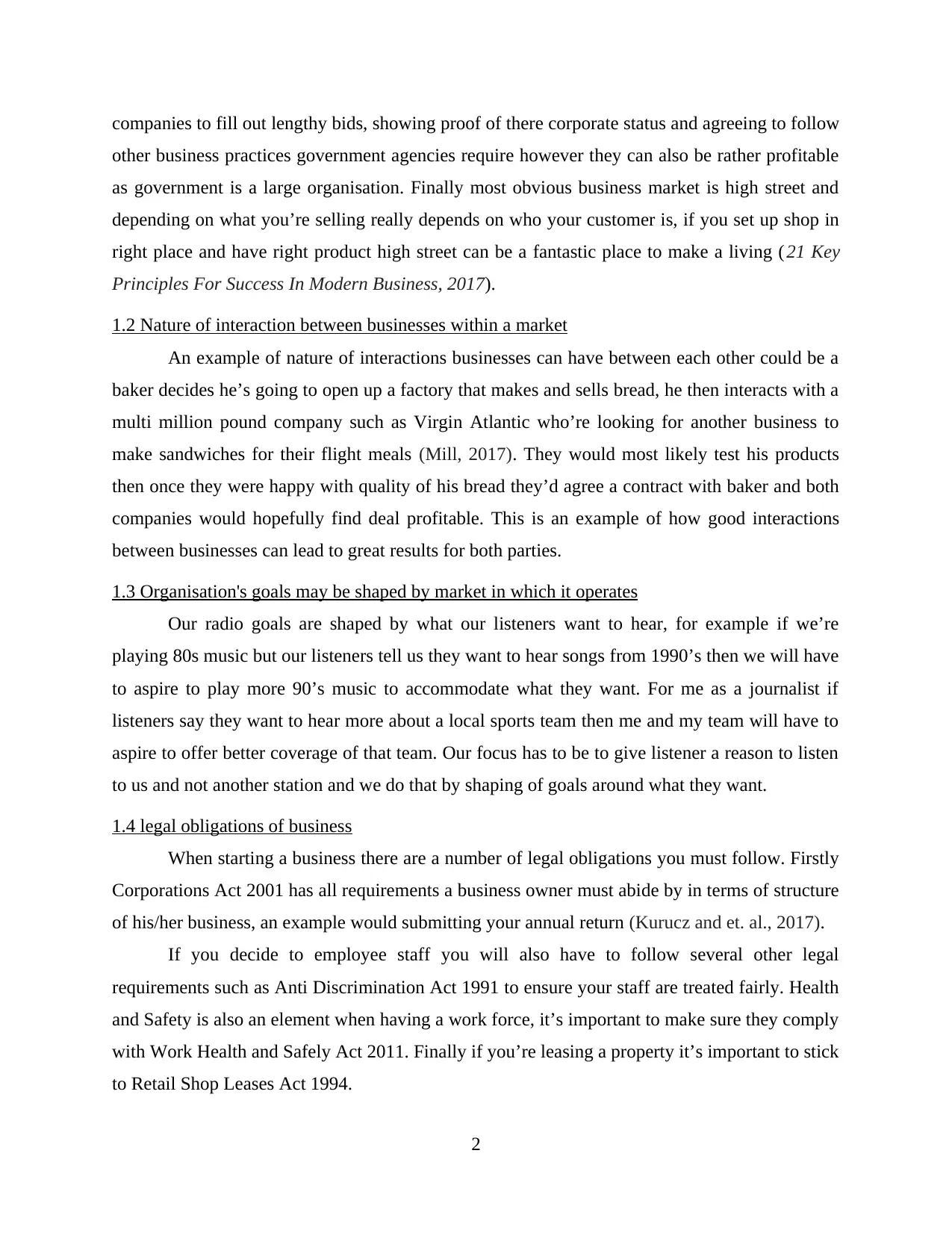
companies to fill out lengthy bids, showing proof of there corporate status and agreeing to follow
other business practices government agencies require however they can also be rather profitable
as government is a large organisation. Finally most obvious business market is high street and
depending on what you’re selling really depends on who your customer is, if you set up shop in
right place and have right product high street can be a fantastic place to make a living (21 Key
Principles For Success In Modern Business, 2017).
1.2 Nature of interaction between businesses within a market
An example of nature of interactions businesses can have between each other could be a
baker decides he’s going to open up a factory that makes and sells bread, he then interacts with a
multi million pound company such as Virgin Atlantic who’re looking for another business to
make sandwiches for their flight meals (Mill, 2017). They would most likely test his products
then once they were happy with quality of his bread they’d agree a contract with baker and both
companies would hopefully find deal profitable. This is an example of how good interactions
between businesses can lead to great results for both parties.
1.3 Organisation's goals may be shaped by market in which it operates
Our radio goals are shaped by what our listeners want to hear, for example if we’re
playing 80s music but our listeners tell us they want to hear songs from 1990’s then we will have
to aspire to play more 90’s music to accommodate what they want. For me as a journalist if
listeners say they want to hear more about a local sports team then me and my team will have to
aspire to offer better coverage of that team. Our focus has to be to give listener a reason to listen
to us and not another station and we do that by shaping of goals around what they want.
1.4 legal obligations of business
When starting a business there are a number of legal obligations you must follow. Firstly
Corporations Act 2001 has all requirements a business owner must abide by in terms of structure
of his/her business, an example would submitting your annual return (Kurucz and et. al., 2017).
If you decide to employee staff you will also have to follow several other legal
requirements such as Anti Discrimination Act 1991 to ensure your staff are treated fairly. Health
and Safety is also an element when having a work force, it’s important to make sure they comply
with Work Health and Safely Act 2011. Finally if you’re leasing a property it’s important to stick
to Retail Shop Leases Act 1994.
2
other business practices government agencies require however they can also be rather profitable
as government is a large organisation. Finally most obvious business market is high street and
depending on what you’re selling really depends on who your customer is, if you set up shop in
right place and have right product high street can be a fantastic place to make a living (21 Key
Principles For Success In Modern Business, 2017).
1.2 Nature of interaction between businesses within a market
An example of nature of interactions businesses can have between each other could be a
baker decides he’s going to open up a factory that makes and sells bread, he then interacts with a
multi million pound company such as Virgin Atlantic who’re looking for another business to
make sandwiches for their flight meals (Mill, 2017). They would most likely test his products
then once they were happy with quality of his bread they’d agree a contract with baker and both
companies would hopefully find deal profitable. This is an example of how good interactions
between businesses can lead to great results for both parties.
1.3 Organisation's goals may be shaped by market in which it operates
Our radio goals are shaped by what our listeners want to hear, for example if we’re
playing 80s music but our listeners tell us they want to hear songs from 1990’s then we will have
to aspire to play more 90’s music to accommodate what they want. For me as a journalist if
listeners say they want to hear more about a local sports team then me and my team will have to
aspire to offer better coverage of that team. Our focus has to be to give listener a reason to listen
to us and not another station and we do that by shaping of goals around what they want.
1.4 legal obligations of business
When starting a business there are a number of legal obligations you must follow. Firstly
Corporations Act 2001 has all requirements a business owner must abide by in terms of structure
of his/her business, an example would submitting your annual return (Kurucz and et. al., 2017).
If you decide to employee staff you will also have to follow several other legal
requirements such as Anti Discrimination Act 1991 to ensure your staff are treated fairly. Health
and Safety is also an element when having a work force, it’s important to make sure they comply
with Work Health and Safely Act 2011. Finally if you’re leasing a property it’s important to stick
to Retail Shop Leases Act 1994.
2
Paraphrase This Document
Need a fresh take? Get an instant paraphrase of this document with our AI Paraphraser
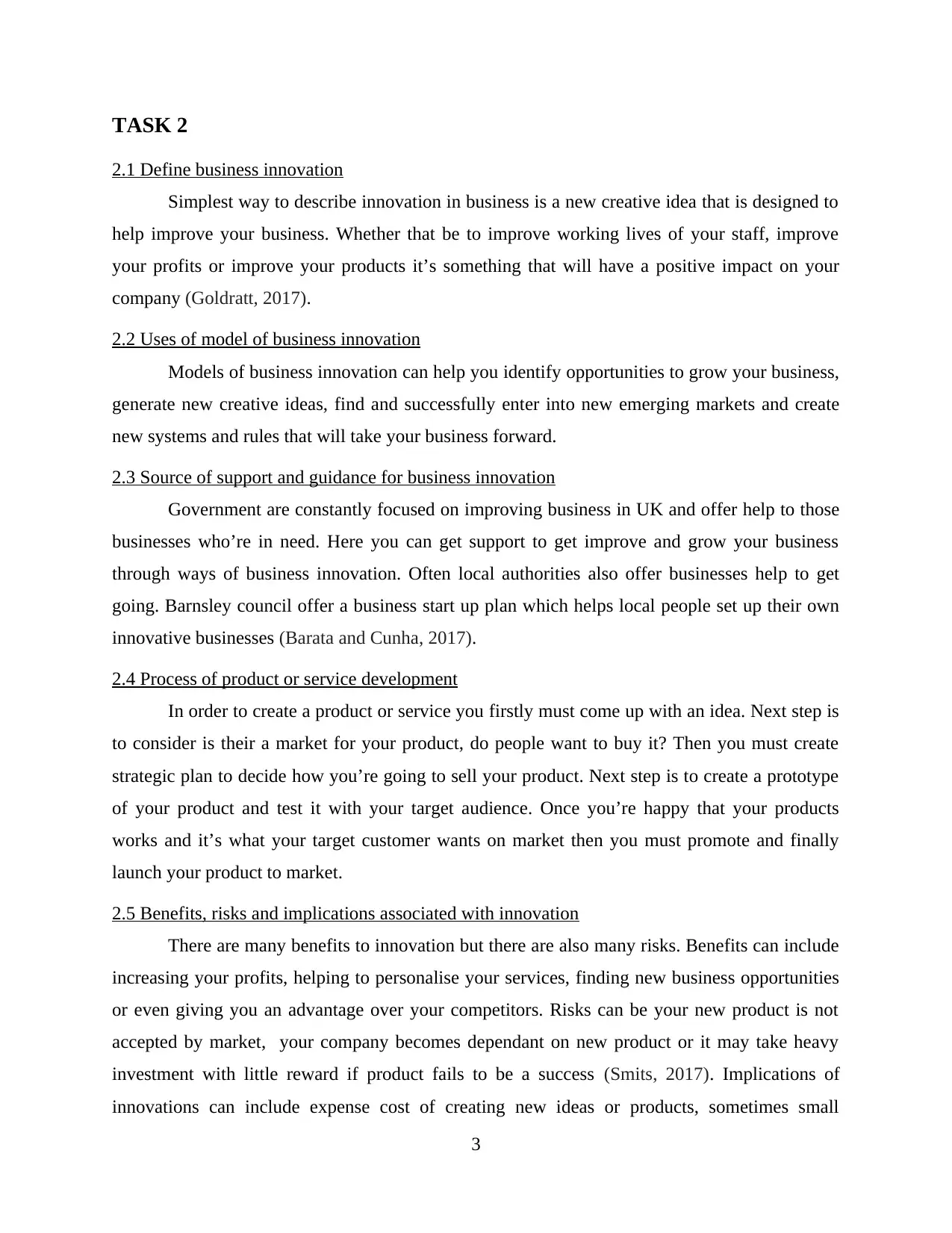
TASK 2
2.1 Define business innovation
Simplest way to describe innovation in business is a new creative idea that is designed to
help improve your business. Whether that be to improve working lives of your staff, improve
your profits or improve your products it’s something that will have a positive impact on your
company (Goldratt, 2017).
2.2 Uses of model of business innovation
Models of business innovation can help you identify opportunities to grow your business,
generate new creative ideas, find and successfully enter into new emerging markets and create
new systems and rules that will take your business forward.
2.3 Source of support and guidance for business innovation
Government are constantly focused on improving business in UK and offer help to those
businesses who’re in need. Here you can get support to get improve and grow your business
through ways of business innovation. Often local authorities also offer businesses help to get
going. Barnsley council offer a business start up plan which helps local people set up their own
innovative businesses (Barata and Cunha, 2017).
2.4 Process of product or service development
In order to create a product or service you firstly must come up with an idea. Next step is
to consider is their a market for your product, do people want to buy it? Then you must create
strategic plan to decide how you’re going to sell your product. Next step is to create a prototype
of your product and test it with your target audience. Once you’re happy that your products
works and it’s what your target customer wants on market then you must promote and finally
launch your product to market.
2.5 Benefits, risks and implications associated with innovation
There are many benefits to innovation but there are also many risks. Benefits can include
increasing your profits, helping to personalise your services, finding new business opportunities
or even giving you an advantage over your competitors. Risks can be your new product is not
accepted by market, your company becomes dependant on new product or it may take heavy
investment with little reward if product fails to be a success (Smits, 2017). Implications of
innovations can include expense cost of creating new ideas or products, sometimes small
3
2.1 Define business innovation
Simplest way to describe innovation in business is a new creative idea that is designed to
help improve your business. Whether that be to improve working lives of your staff, improve
your profits or improve your products it’s something that will have a positive impact on your
company (Goldratt, 2017).
2.2 Uses of model of business innovation
Models of business innovation can help you identify opportunities to grow your business,
generate new creative ideas, find and successfully enter into new emerging markets and create
new systems and rules that will take your business forward.
2.3 Source of support and guidance for business innovation
Government are constantly focused on improving business in UK and offer help to those
businesses who’re in need. Here you can get support to get improve and grow your business
through ways of business innovation. Often local authorities also offer businesses help to get
going. Barnsley council offer a business start up plan which helps local people set up their own
innovative businesses (Barata and Cunha, 2017).
2.4 Process of product or service development
In order to create a product or service you firstly must come up with an idea. Next step is
to consider is their a market for your product, do people want to buy it? Then you must create
strategic plan to decide how you’re going to sell your product. Next step is to create a prototype
of your product and test it with your target audience. Once you’re happy that your products
works and it’s what your target customer wants on market then you must promote and finally
launch your product to market.
2.5 Benefits, risks and implications associated with innovation
There are many benefits to innovation but there are also many risks. Benefits can include
increasing your profits, helping to personalise your services, finding new business opportunities
or even giving you an advantage over your competitors. Risks can be your new product is not
accepted by market, your company becomes dependant on new product or it may take heavy
investment with little reward if product fails to be a success (Smits, 2017). Implications of
innovations can include expense cost of creating new ideas or products, sometimes small
3
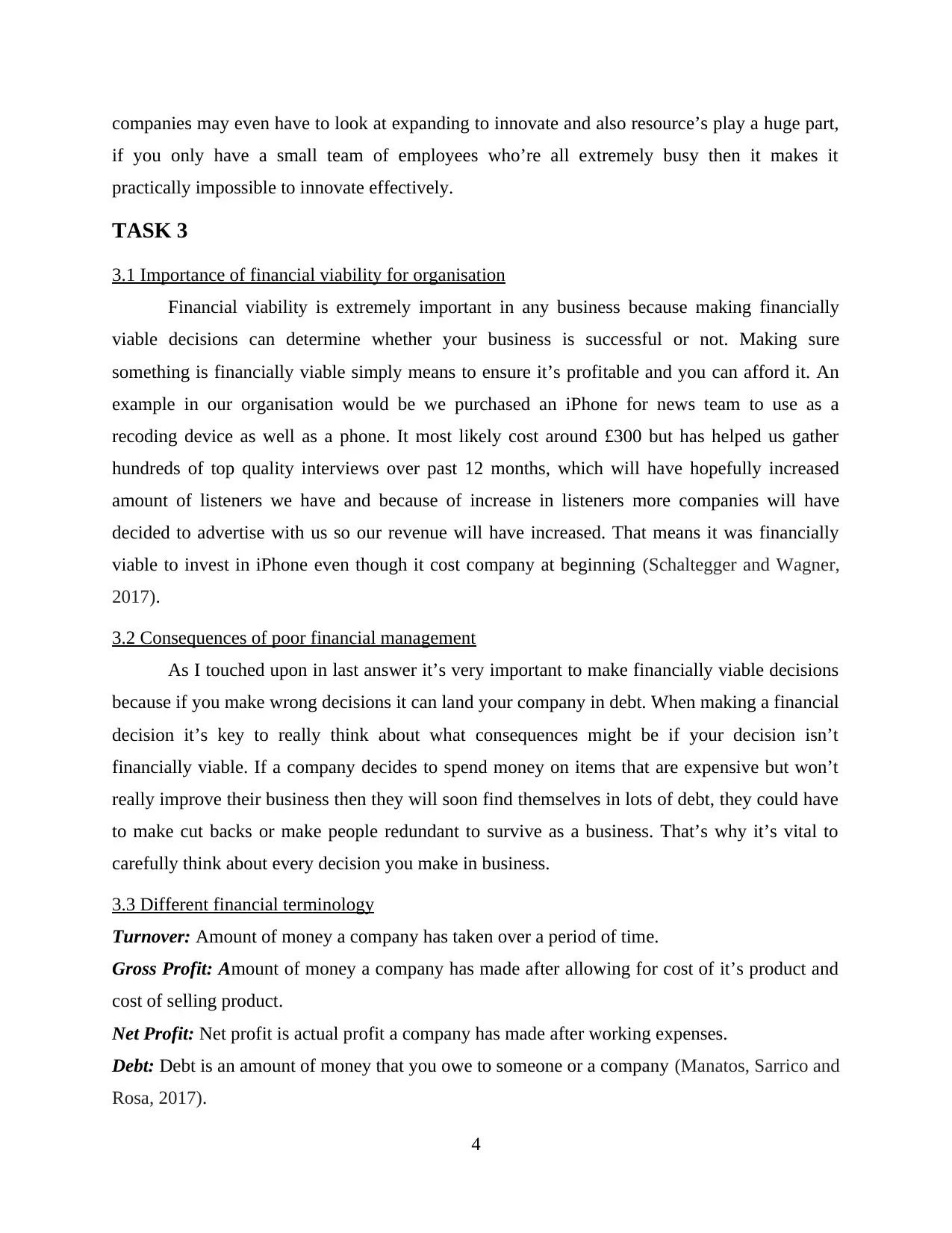
companies may even have to look at expanding to innovate and also resource’s play a huge part,
if you only have a small team of employees who’re all extremely busy then it makes it
practically impossible to innovate effectively.
TASK 3
3.1 Importance of financial viability for organisation
Financial viability is extremely important in any business because making financially
viable decisions can determine whether your business is successful or not. Making sure
something is financially viable simply means to ensure it’s profitable and you can afford it. An
example in our organisation would be we purchased an iPhone for news team to use as a
recoding device as well as a phone. It most likely cost around £300 but has helped us gather
hundreds of top quality interviews over past 12 months, which will have hopefully increased
amount of listeners we have and because of increase in listeners more companies will have
decided to advertise with us so our revenue will have increased. That means it was financially
viable to invest in iPhone even though it cost company at beginning (Schaltegger and Wagner,
2017).
3.2 Consequences of poor financial management
As I touched upon in last answer it’s very important to make financially viable decisions
because if you make wrong decisions it can land your company in debt. When making a financial
decision it’s key to really think about what consequences might be if your decision isn’t
financially viable. If a company decides to spend money on items that are expensive but won’t
really improve their business then they will soon find themselves in lots of debt, they could have
to make cut backs or make people redundant to survive as a business. That’s why it’s vital to
carefully think about every decision you make in business.
3.3 Different financial terminology
Turnover: Amount of money a company has taken over a period of time.
Gross Profit: Amount of money a company has made after allowing for cost of it’s product and
cost of selling product.
Net Profit: Net profit is actual profit a company has made after working expenses.
Debt: Debt is an amount of money that you owe to someone or a company (Manatos, Sarrico and
Rosa, 2017).
4
if you only have a small team of employees who’re all extremely busy then it makes it
practically impossible to innovate effectively.
TASK 3
3.1 Importance of financial viability for organisation
Financial viability is extremely important in any business because making financially
viable decisions can determine whether your business is successful or not. Making sure
something is financially viable simply means to ensure it’s profitable and you can afford it. An
example in our organisation would be we purchased an iPhone for news team to use as a
recoding device as well as a phone. It most likely cost around £300 but has helped us gather
hundreds of top quality interviews over past 12 months, which will have hopefully increased
amount of listeners we have and because of increase in listeners more companies will have
decided to advertise with us so our revenue will have increased. That means it was financially
viable to invest in iPhone even though it cost company at beginning (Schaltegger and Wagner,
2017).
3.2 Consequences of poor financial management
As I touched upon in last answer it’s very important to make financially viable decisions
because if you make wrong decisions it can land your company in debt. When making a financial
decision it’s key to really think about what consequences might be if your decision isn’t
financially viable. If a company decides to spend money on items that are expensive but won’t
really improve their business then they will soon find themselves in lots of debt, they could have
to make cut backs or make people redundant to survive as a business. That’s why it’s vital to
carefully think about every decision you make in business.
3.3 Different financial terminology
Turnover: Amount of money a company has taken over a period of time.
Gross Profit: Amount of money a company has made after allowing for cost of it’s product and
cost of selling product.
Net Profit: Net profit is actual profit a company has made after working expenses.
Debt: Debt is an amount of money that you owe to someone or a company (Manatos, Sarrico and
Rosa, 2017).
4
⊘ This is a preview!⊘
Do you want full access?
Subscribe today to unlock all pages.

Trusted by 1+ million students worldwide
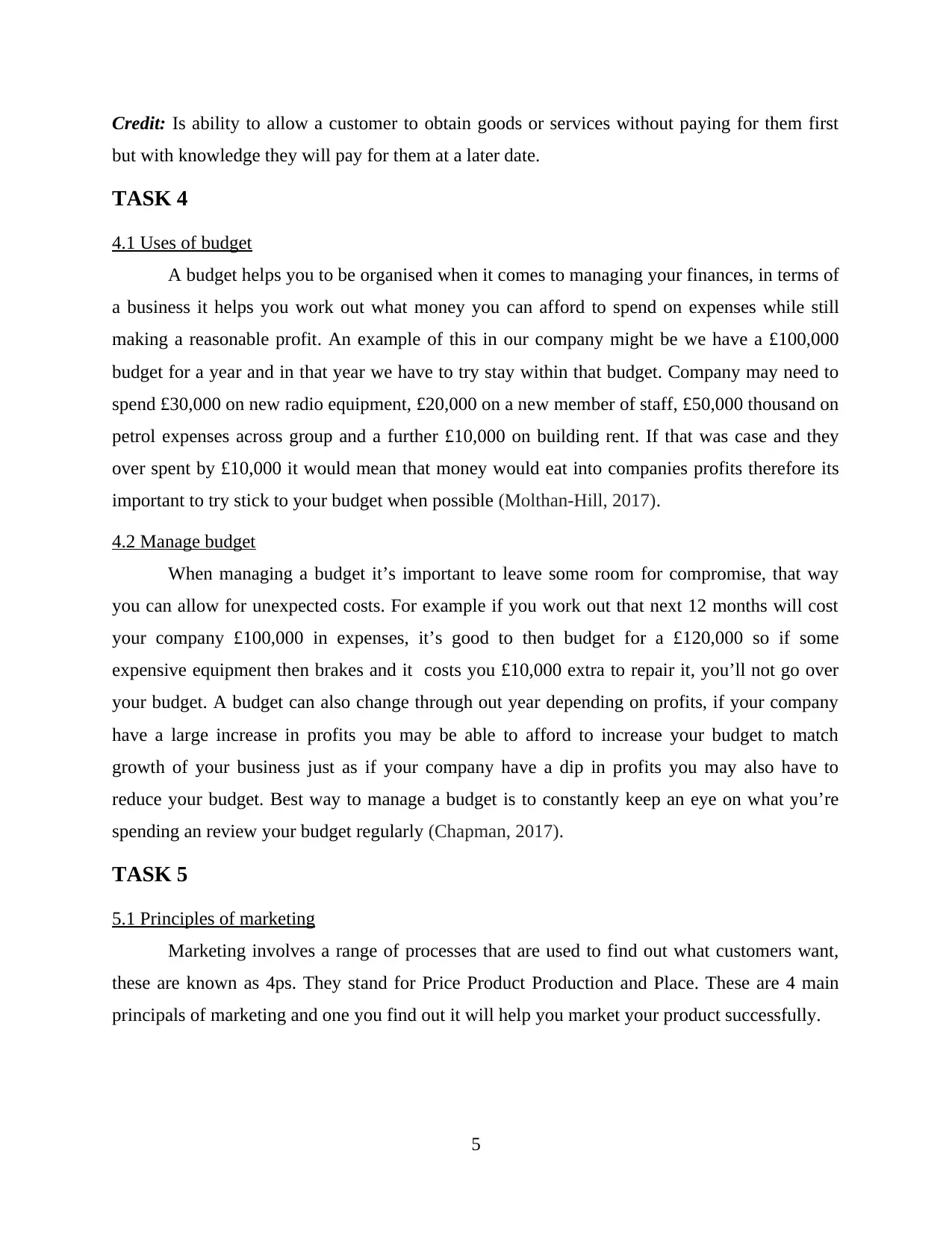
Credit: Is ability to allow a customer to obtain goods or services without paying for them first
but with knowledge they will pay for them at a later date.
TASK 4
4.1 Uses of budget
A budget helps you to be organised when it comes to managing your finances, in terms of
a business it helps you work out what money you can afford to spend on expenses while still
making a reasonable profit. An example of this in our company might be we have a £100,000
budget for a year and in that year we have to try stay within that budget. Company may need to
spend £30,000 on new radio equipment, £20,000 on a new member of staff, £50,000 thousand on
petrol expenses across group and a further £10,000 on building rent. If that was case and they
over spent by £10,000 it would mean that money would eat into companies profits therefore its
important to try stick to your budget when possible (Molthan-Hill, 2017).
4.2 Manage budget
When managing a budget it’s important to leave some room for compromise, that way
you can allow for unexpected costs. For example if you work out that next 12 months will cost
your company £100,000 in expenses, it’s good to then budget for a £120,000 so if some
expensive equipment then brakes and it costs you £10,000 extra to repair it, you’ll not go over
your budget. A budget can also change through out year depending on profits, if your company
have a large increase in profits you may be able to afford to increase your budget to match
growth of your business just as if your company have a dip in profits you may also have to
reduce your budget. Best way to manage a budget is to constantly keep an eye on what you’re
spending an review your budget regularly (Chapman, 2017).
TASK 5
5.1 Principles of marketing
Marketing involves a range of processes that are used to find out what customers want,
these are known as 4ps. They stand for Price Product Production and Place. These are 4 main
principals of marketing and one you find out it will help you market your product successfully.
5
but with knowledge they will pay for them at a later date.
TASK 4
4.1 Uses of budget
A budget helps you to be organised when it comes to managing your finances, in terms of
a business it helps you work out what money you can afford to spend on expenses while still
making a reasonable profit. An example of this in our company might be we have a £100,000
budget for a year and in that year we have to try stay within that budget. Company may need to
spend £30,000 on new radio equipment, £20,000 on a new member of staff, £50,000 thousand on
petrol expenses across group and a further £10,000 on building rent. If that was case and they
over spent by £10,000 it would mean that money would eat into companies profits therefore its
important to try stick to your budget when possible (Molthan-Hill, 2017).
4.2 Manage budget
When managing a budget it’s important to leave some room for compromise, that way
you can allow for unexpected costs. For example if you work out that next 12 months will cost
your company £100,000 in expenses, it’s good to then budget for a £120,000 so if some
expensive equipment then brakes and it costs you £10,000 extra to repair it, you’ll not go over
your budget. A budget can also change through out year depending on profits, if your company
have a large increase in profits you may be able to afford to increase your budget to match
growth of your business just as if your company have a dip in profits you may also have to
reduce your budget. Best way to manage a budget is to constantly keep an eye on what you’re
spending an review your budget regularly (Chapman, 2017).
TASK 5
5.1 Principles of marketing
Marketing involves a range of processes that are used to find out what customers want,
these are known as 4ps. They stand for Price Product Production and Place. These are 4 main
principals of marketing and one you find out it will help you market your product successfully.
5
Paraphrase This Document
Need a fresh take? Get an instant paraphrase of this document with our AI Paraphraser
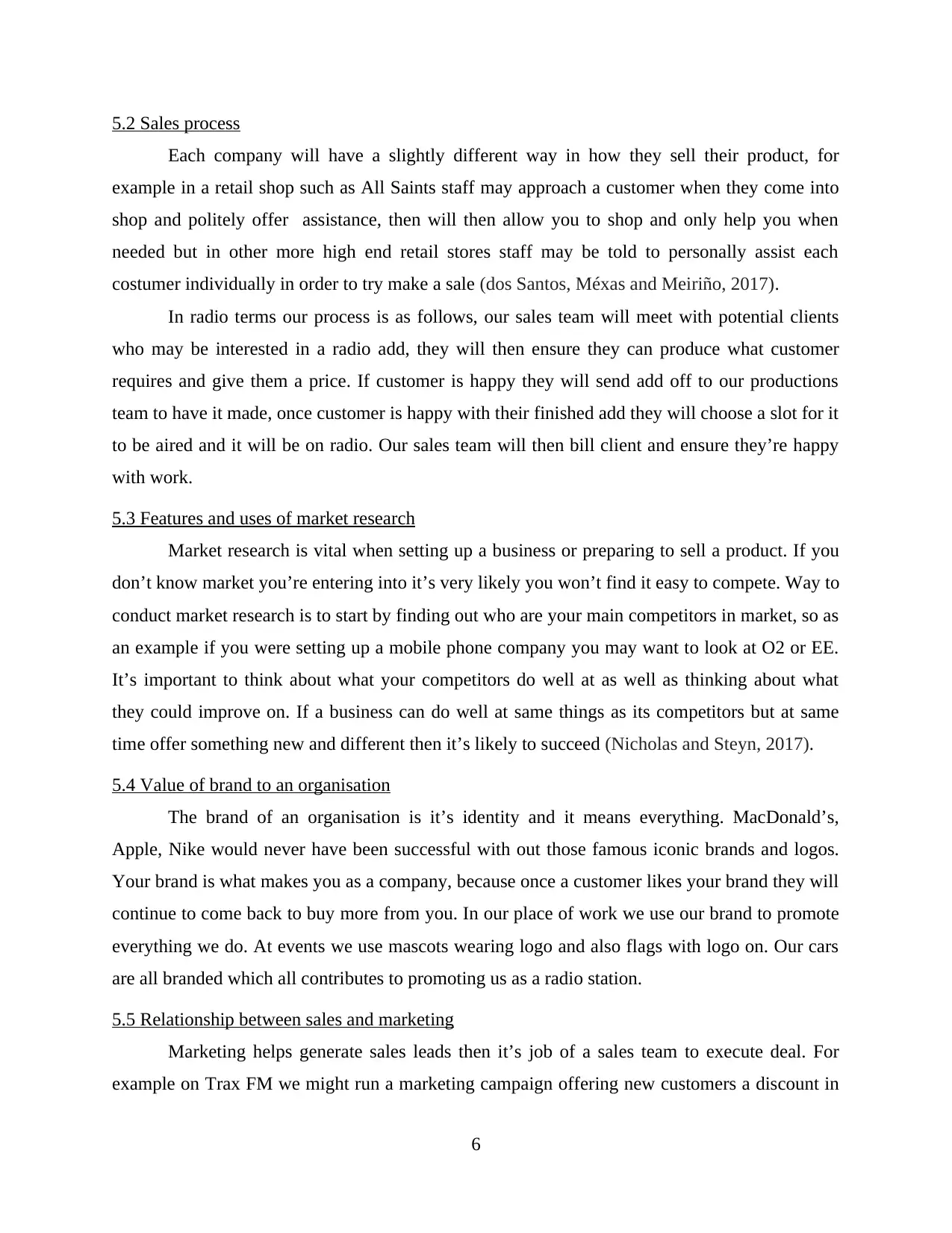
5.2 Sales process
Each company will have a slightly different way in how they sell their product, for
example in a retail shop such as All Saints staff may approach a customer when they come into
shop and politely offer assistance, then will then allow you to shop and only help you when
needed but in other more high end retail stores staff may be told to personally assist each
costumer individually in order to try make a sale (dos Santos, Méxas and Meiriño, 2017).
In radio terms our process is as follows, our sales team will meet with potential clients
who may be interested in a radio add, they will then ensure they can produce what customer
requires and give them a price. If customer is happy they will send add off to our productions
team to have it made, once customer is happy with their finished add they will choose a slot for it
to be aired and it will be on radio. Our sales team will then bill client and ensure they’re happy
with work.
5.3 Features and uses of market research
Market research is vital when setting up a business or preparing to sell a product. If you
don’t know market you’re entering into it’s very likely you won’t find it easy to compete. Way to
conduct market research is to start by finding out who are your main competitors in market, so as
an example if you were setting up a mobile phone company you may want to look at O2 or EE.
It’s important to think about what your competitors do well at as well as thinking about what
they could improve on. If a business can do well at same things as its competitors but at same
time offer something new and different then it’s likely to succeed (Nicholas and Steyn, 2017).
5.4 Value of brand to an organisation
The brand of an organisation is it’s identity and it means everything. MacDonald’s,
Apple, Nike would never have been successful with out those famous iconic brands and logos.
Your brand is what makes you as a company, because once a customer likes your brand they will
continue to come back to buy more from you. In our place of work we use our brand to promote
everything we do. At events we use mascots wearing logo and also flags with logo on. Our cars
are all branded which all contributes to promoting us as a radio station.
5.5 Relationship between sales and marketing
Marketing helps generate sales leads then it’s job of a sales team to execute deal. For
example on Trax FM we might run a marketing campaign offering new customers a discount in
6
Each company will have a slightly different way in how they sell their product, for
example in a retail shop such as All Saints staff may approach a customer when they come into
shop and politely offer assistance, then will then allow you to shop and only help you when
needed but in other more high end retail stores staff may be told to personally assist each
costumer individually in order to try make a sale (dos Santos, Méxas and Meiriño, 2017).
In radio terms our process is as follows, our sales team will meet with potential clients
who may be interested in a radio add, they will then ensure they can produce what customer
requires and give them a price. If customer is happy they will send add off to our productions
team to have it made, once customer is happy with their finished add they will choose a slot for it
to be aired and it will be on radio. Our sales team will then bill client and ensure they’re happy
with work.
5.3 Features and uses of market research
Market research is vital when setting up a business or preparing to sell a product. If you
don’t know market you’re entering into it’s very likely you won’t find it easy to compete. Way to
conduct market research is to start by finding out who are your main competitors in market, so as
an example if you were setting up a mobile phone company you may want to look at O2 or EE.
It’s important to think about what your competitors do well at as well as thinking about what
they could improve on. If a business can do well at same things as its competitors but at same
time offer something new and different then it’s likely to succeed (Nicholas and Steyn, 2017).
5.4 Value of brand to an organisation
The brand of an organisation is it’s identity and it means everything. MacDonald’s,
Apple, Nike would never have been successful with out those famous iconic brands and logos.
Your brand is what makes you as a company, because once a customer likes your brand they will
continue to come back to buy more from you. In our place of work we use our brand to promote
everything we do. At events we use mascots wearing logo and also flags with logo on. Our cars
are all branded which all contributes to promoting us as a radio station.
5.5 Relationship between sales and marketing
Marketing helps generate sales leads then it’s job of a sales team to execute deal. For
example on Trax FM we might run a marketing campaign offering new customers a discount in
6
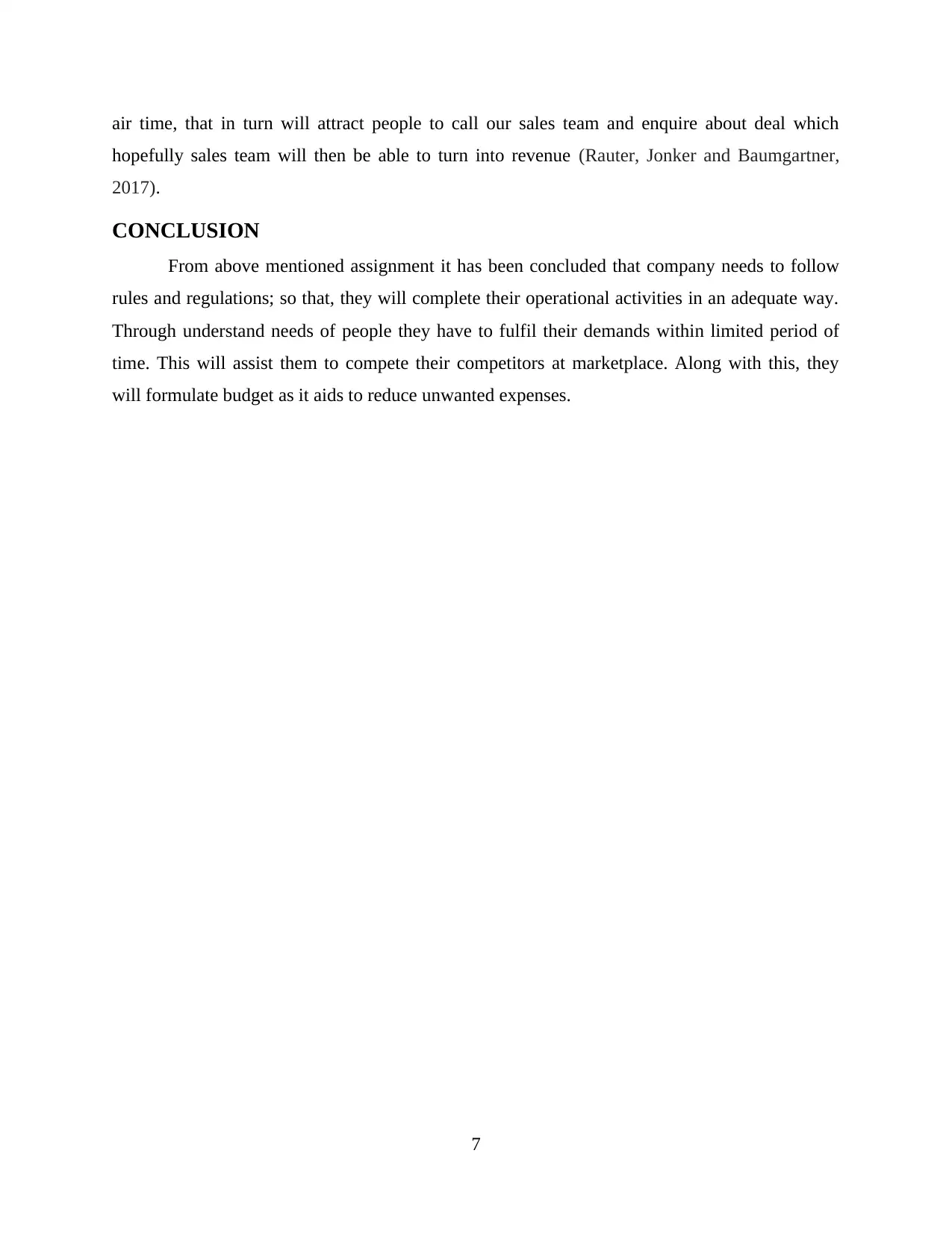
air time, that in turn will attract people to call our sales team and enquire about deal which
hopefully sales team will then be able to turn into revenue (Rauter, Jonker and Baumgartner,
2017).
CONCLUSION
From above mentioned assignment it has been concluded that company needs to follow
rules and regulations; so that, they will complete their operational activities in an adequate way.
Through understand needs of people they have to fulfil their demands within limited period of
time. This will assist them to compete their competitors at marketplace. Along with this, they
will formulate budget as it aids to reduce unwanted expenses.
7
hopefully sales team will then be able to turn into revenue (Rauter, Jonker and Baumgartner,
2017).
CONCLUSION
From above mentioned assignment it has been concluded that company needs to follow
rules and regulations; so that, they will complete their operational activities in an adequate way.
Through understand needs of people they have to fulfil their demands within limited period of
time. This will assist them to compete their competitors at marketplace. Along with this, they
will formulate budget as it aids to reduce unwanted expenses.
7
⊘ This is a preview!⊘
Do you want full access?
Subscribe today to unlock all pages.

Trusted by 1+ million students worldwide
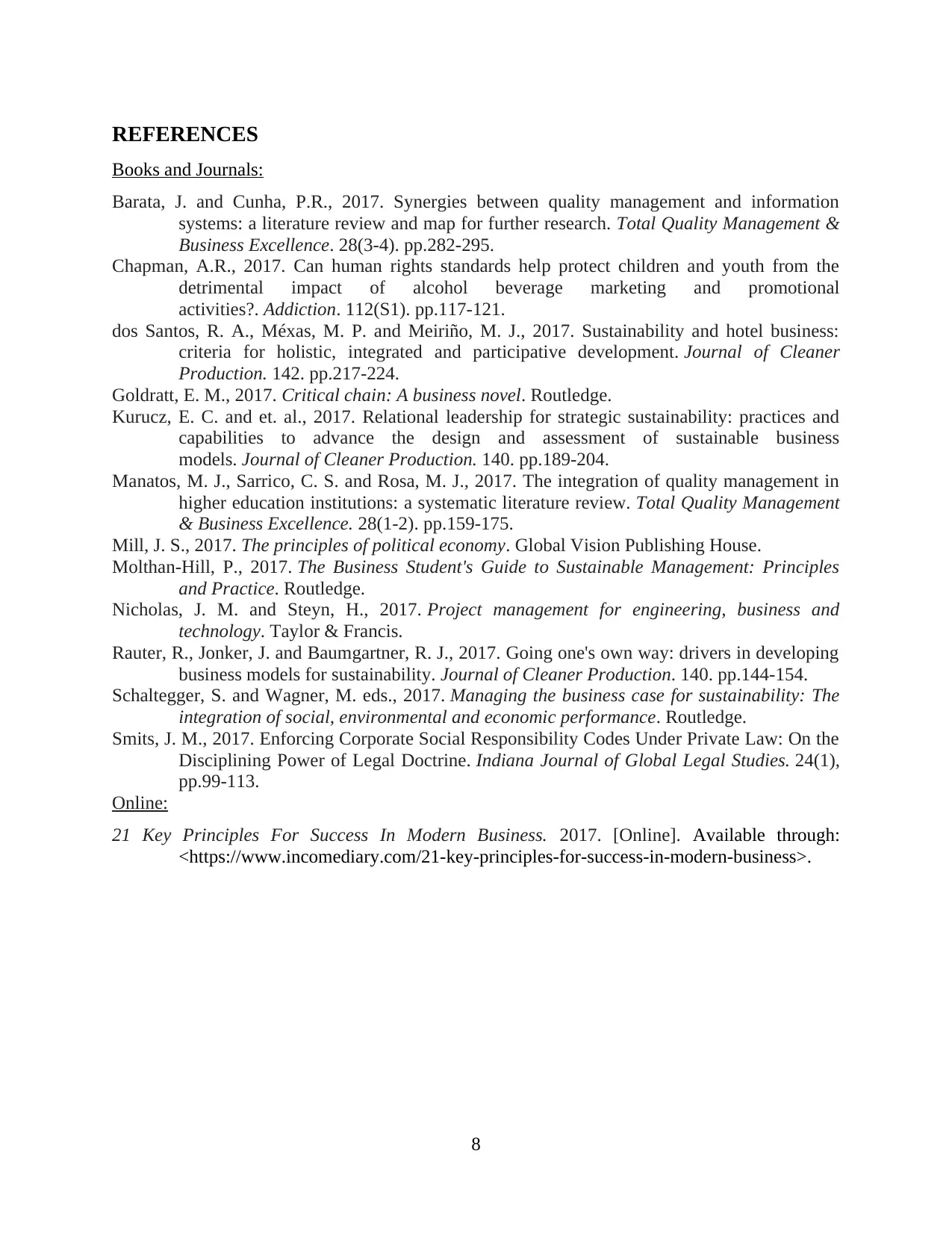
REFERENCES
Books and Journals:
Barata, J. and Cunha, P.R., 2017. Synergies between quality management and information
systems: a literature review and map for further research. Total Quality Management &
Business Excellence. 28(3-4). pp.282-295.
Chapman, A.R., 2017. Can human rights standards help protect children and youth from the
detrimental impact of alcohol beverage marketing and promotional
activities?. Addiction. 112(S1). pp.117-121.
dos Santos, R. A., Méxas, M. P. and Meiriño, M. J., 2017. Sustainability and hotel business:
criteria for holistic, integrated and participative development. Journal of Cleaner
Production. 142. pp.217-224.
Goldratt, E. M., 2017. Critical chain: A business novel. Routledge.
Kurucz, E. C. and et. al., 2017. Relational leadership for strategic sustainability: practices and
capabilities to advance the design and assessment of sustainable business
models. Journal of Cleaner Production. 140. pp.189-204.
Manatos, M. J., Sarrico, C. S. and Rosa, M. J., 2017. The integration of quality management in
higher education institutions: a systematic literature review. Total Quality Management
& Business Excellence. 28(1-2). pp.159-175.
Mill, J. S., 2017. The principles of political economy. Global Vision Publishing House.
Molthan-Hill, P., 2017. The Business Student's Guide to Sustainable Management: Principles
and Practice. Routledge.
Nicholas, J. M. and Steyn, H., 2017. Project management for engineering, business and
technology. Taylor & Francis.
Rauter, R., Jonker, J. and Baumgartner, R. J., 2017. Going one's own way: drivers in developing
business models for sustainability. Journal of Cleaner Production. 140. pp.144-154.
Schaltegger, S. and Wagner, M. eds., 2017. Managing the business case for sustainability: The
integration of social, environmental and economic performance. Routledge.
Smits, J. M., 2017. Enforcing Corporate Social Responsibility Codes Under Private Law: On the
Disciplining Power of Legal Doctrine. Indiana Journal of Global Legal Studies. 24(1),
pp.99-113.
Online:
21 Key Principles For Success In Modern Business. 2017. [Online]. Available through:
<https://www.incomediary.com/21-key-principles-for-success-in-modern-business>.
8
Books and Journals:
Barata, J. and Cunha, P.R., 2017. Synergies between quality management and information
systems: a literature review and map for further research. Total Quality Management &
Business Excellence. 28(3-4). pp.282-295.
Chapman, A.R., 2017. Can human rights standards help protect children and youth from the
detrimental impact of alcohol beverage marketing and promotional
activities?. Addiction. 112(S1). pp.117-121.
dos Santos, R. A., Méxas, M. P. and Meiriño, M. J., 2017. Sustainability and hotel business:
criteria for holistic, integrated and participative development. Journal of Cleaner
Production. 142. pp.217-224.
Goldratt, E. M., 2017. Critical chain: A business novel. Routledge.
Kurucz, E. C. and et. al., 2017. Relational leadership for strategic sustainability: practices and
capabilities to advance the design and assessment of sustainable business
models. Journal of Cleaner Production. 140. pp.189-204.
Manatos, M. J., Sarrico, C. S. and Rosa, M. J., 2017. The integration of quality management in
higher education institutions: a systematic literature review. Total Quality Management
& Business Excellence. 28(1-2). pp.159-175.
Mill, J. S., 2017. The principles of political economy. Global Vision Publishing House.
Molthan-Hill, P., 2017. The Business Student's Guide to Sustainable Management: Principles
and Practice. Routledge.
Nicholas, J. M. and Steyn, H., 2017. Project management for engineering, business and
technology. Taylor & Francis.
Rauter, R., Jonker, J. and Baumgartner, R. J., 2017. Going one's own way: drivers in developing
business models for sustainability. Journal of Cleaner Production. 140. pp.144-154.
Schaltegger, S. and Wagner, M. eds., 2017. Managing the business case for sustainability: The
integration of social, environmental and economic performance. Routledge.
Smits, J. M., 2017. Enforcing Corporate Social Responsibility Codes Under Private Law: On the
Disciplining Power of Legal Doctrine. Indiana Journal of Global Legal Studies. 24(1),
pp.99-113.
Online:
21 Key Principles For Success In Modern Business. 2017. [Online]. Available through:
<https://www.incomediary.com/21-key-principles-for-success-in-modern-business>.
8
1 out of 10
Related Documents
Your All-in-One AI-Powered Toolkit for Academic Success.
+13062052269
info@desklib.com
Available 24*7 on WhatsApp / Email
![[object Object]](/_next/static/media/star-bottom.7253800d.svg)
Unlock your academic potential
Copyright © 2020–2025 A2Z Services. All Rights Reserved. Developed and managed by ZUCOL.





